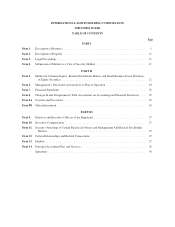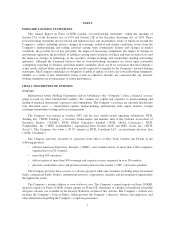INTL FCStone 2005 Annual Report Download - page 20
Download and view the complete annual report
Please find page 20 of the 2005 INTL FCStone annual report below. You can navigate through the pages in the report by either clicking on the pages listed below, or by using the keyword search tool below to find specific information within the annual report.industrial batteries (“batteries”) on behalf of the Company. In the event that these third parties fail to comply
with federal, state or foreign environmental laws in handling or disposing of these batteries and other hazardous
substances used in or arising from the recycling of these batteries, the Company may be exposed to claims for the
cost of remediating sites impacted by such improper handling and disposal, as well as other related costs. The
Company seeks to mitigate this risk by dealing with third parties whom the Company believes are in compliance
with applicable laws and which have established reputations in the industry.
Dependence on technology and communications systems
The Company’s market-making and trading activities depend on the integrity and performance of the
computer and communications systems supporting them. Extraordinary trading volumes or other events could
cause the Company’s computer systems to operate at an unacceptably low speed or even fail. Any significant
degradation or failure of the Company’s computer systems or any other systems in the trading process could
cause customers to suffer delays in trading. These delays could cause substantial losses for customers and could
subject the Company to claims from customers for losses. It is possible that the Company’s network protections
may not work properly. The Company’s systems may also fail as a result of:
• a tornado, hurricane, fire or other natural disasters
• power or telecommunications failure
• acts of God
• computer hacking activities
• terrorism
•war
Any computer or communications system failure or decrease in computer systems performance that causes
interruptions in the Company’s operations could have a material adverse effect on its business, financial
condition and operating results.
Dependence on a limited group of customers
Based on management’s assessment of the Company’s business, the Company believes that a small number
of its customers account for a significant portion of the Company’s revenues in each of its businesses. The
Company is unable to measure the level of this concentration because the Company’s dealing activities do not
permit the Company to quantify revenues generated by each customer. The Company expects a significant
portion of the future demand for each of its market-making and trading services to remain concentrated within a
limited number of customers. None of these customers are obligated contractually to use the Company’s market-
making or trading services. Accordingly, these customers may direct their trading activities to other market-
makers or traders at any time. The loss of or a significant reduction in demand for the Company’s services from
any of these customers could have a material adverse effect on the Company’s business, financial condition and
operating results.
Risk Management
The Company seeks to mitigate the market and credit risks arising from its financial trading activities
through an active risk management program. The principal objective of this program is to limit trading risk to an
acceptable level while maximizing the return generated on the risk assumed.
The Company has a defined risk policy which is administered by the Company’s risk committee, which
reports to the Company’s audit committee. The Company has established specific exposure limits for inventory
positions in every business, as well as specific issuer limits and counterparty limits. These limits are designed to
10
























